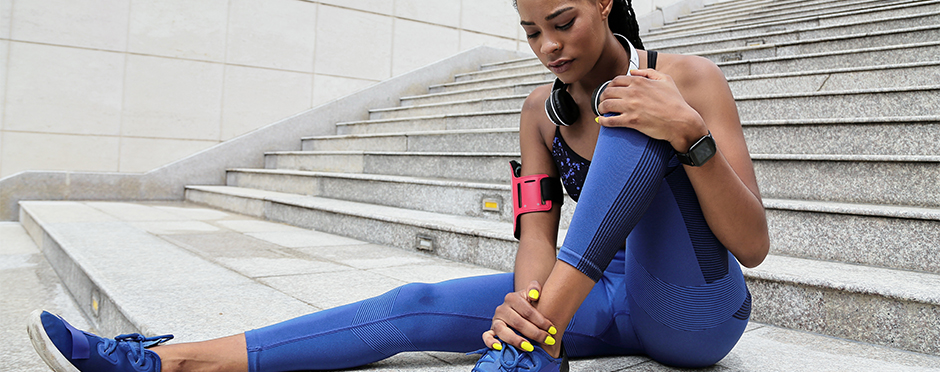
Is Your Ankle Mobility Holding Back Your Running
1 CommentRunners are known to push into pain in pursuit of their goals. Setting a new 5k PR or training for a marathon involves an unavoidable degree of discomfort. However, some nagging aches and pains are our body’s way of telling us something needs fixing. Whether you are a rearfoot or forefoot runner, a large amount of force goes through your ankle when you run1. While knee or ankle pain could be normal delayed-onset muscle soreness (DOMS) from running, it could also be related to ankle mobility2.
Our ankles move in many directions, but with running, we are primarily concerned with plantarflexion and dorsiflexion. Ankle plantarflexion is the foot’s movement down away from the shin, such as standing on your toes or pushing your foot on a brake pedal. Ankle dorsiflexion is the foot’s movement away and toward the shin, such as when you tap your toes or lift your foot off a brake pedal. Of these two, as a physical therapist, I primarily see restricted ankle dorsiflexion in my patients with running injuries.
Normally our ankles can dorsiflex about 10 to 20 degrees past neutral.7 Restricted ankle dorsiflexion range of motion can negatively impact your running performance.3 Stretching and mobilizing your ankle joint can improve your ankle range of motion.5,6 Here is how to perform a quick assessment of your ankle dorsiflexion, and how to mobilize and stretch for improved ankle dorsiflexion.
Ankle Dorsiflexion Quick Test
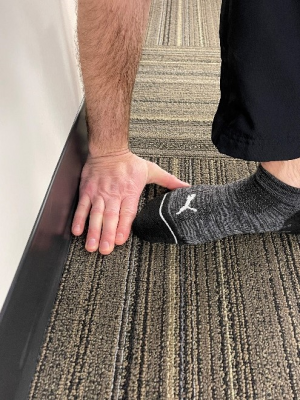
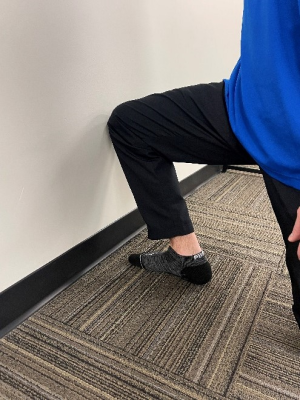
Remove your shoe and stand with your toes 3-4 inches from the wall. Keeping your heel planted on the ground, lean forward so your knee approaches the wall. The goal is to touch the wall with your heel remaining on the floor.
Did you touch the wall with your heel planted? Congratulations! Your ankle dorsiflexion mobility is likely appropriate for running. Did your heel rise, or could you not touch your knee to the wall? See the methods below!
Ankle Dorsiflexion Mobilization
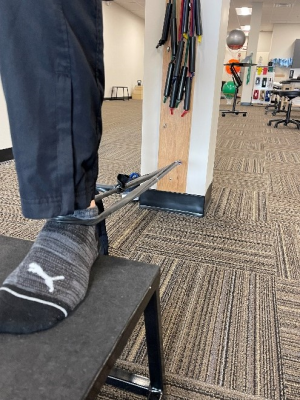
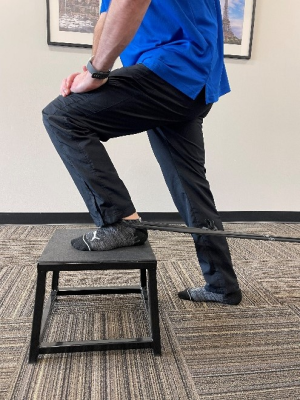
Attach a thin elastic band behind you, then step through the loop. The band should be below the level of the malleoli (the two bony bumps on the outside of your ankle). Step your foot onto an elevated surface. Lean forward so your knee tracks above your toes, ensuring your heel stays planted. Repeat in a slow, controlled manner for 30-60 seconds.
Ankle Stretch At The Wall
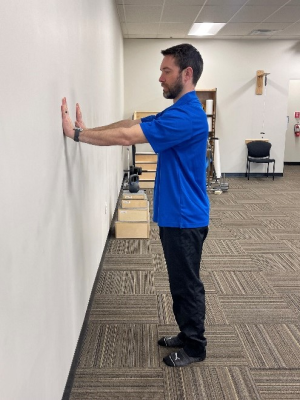
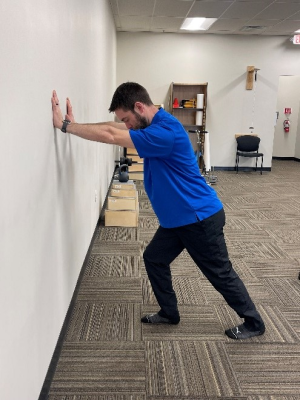
Stand an arm’s length away from the wall. Step your affected leg back, with your toes pointing straight at the wall. Lean forward towards the wall, making sure your heel stays planted. Hold for 30-60 seconds.
Ankle Stretch on Incline board
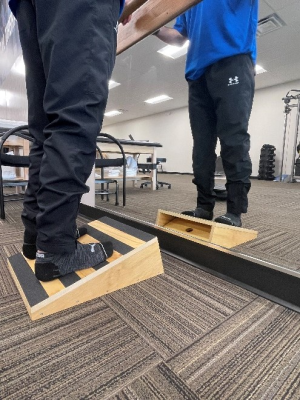
Look for a sturdy incline board close to a wall to hold on to for balance. If you don’t have an incline board, you can place small weights under the front of a board to make a slope. Keep your toes pointed forward and your knees straight and maintain a forward lean. Hold this forward lean for 30-60 seconds.
If you try these ankle methods and are still dealing with running injuries, contact your nearest Athletico for a free assessment. Free Assessments are available in the clinic or virtually through our Telehealth platform.
*Per federal guidelines, beneficiaries of plans such as Medicare, Medicaid, Tricare, VHA and other federally funded plans are not eligible for free assessments.
The Athletico blog is an educational resource written by Athletico employees. Athletico bloggers are licensed professionals who abide by the code of ethics outlined by their respective professional associations. The content published in blog posts represents the opinion of the individual author based on their expertise and experience. The content provided in this blog is for informational purposes only, does not constitute medical advice and should not be relied on for making personal health decisions.
References:
1. Front foot strike leads to higher force through the foot and ankle
– (Xu Y, Yuan P, Wang R, Wang D, Liu J, Zhou H. Effects of Foot Strike Techniques on Running Biomechanics: A Systematic Review and Meta-analysis. Sports Health. 2021 Jan/Feb;13(1):71-77. doi: 10.1177/1941738120934715. Epub 2020 Aug 19. PMID: 32813597; PMCID: PMC7734358.)
2. Knee pain (patellofemoral syndrome or IT band pain syndrome), shin pain (Medial Tibial stress syndrome “shin splints”) and ankle (Achilles tendinopathy) or foot (plantar fasciitis) are most common running injuries.
– Lopes AD, Hespanhol Júnior LC, Yeung SS, Costa LO. What are the main running-related musculoskeletal injuries? A Systematic Review. Sports Med. 2012 Oct 1;42(10):891-905. doi: 10.1007/BF03262301. PMID: 22827721; PMCID: PMC4269925.
3. Stiff ankles can actually be a cause of knee pain
– Lima YL, Ferreira VMLM, de Paula Lima PO, Bezerra MA, de Oliveira RR, Almeida GPL. The association of ankle dorsiflexion and dynamic knee valgus: A systematic review and meta-analysis. Phys Ther Sport. 2018 Jan;29:61-69. doi: 10.1016/j.ptsp.2017.07.003. Epub 2017 Jul 19. PMID: 28974358.
4. Incline board more effective than wall stretching
– Kim TH, Lim OK, Park KD, Lee JK. Comparison of Two Static Stretching Techniques for the Triceps Surae in Healthy Individuals: Wall and Inclined Board Stretchings. Ann Rehabil Med. 2020 Apr;44(2):125-130. doi: 10.5535/arm.2020.44.2.125. Epub 2020 Apr 29. PMID: 32392651; PMCID: PMC7214133.
5. Static stretching can improve ankle dorsiflexion
– Radford JA, Burns J, Buchbinder R, Landorf KB, Cook C. Does stretching increase ankle dorsiflexion range of motion? A systematic review. Br J Sports Med. 2006 Oct;40(10):870-5; discussion 875. doi: 10.1136/bjsm.2006.029348. Epub 2006 Aug 22. PMID: 16926259; PMCID: PMC2465055.
6. Static stretching is effective at improving ankle dorsiflexion ROM
– Medeiros DM, Martini TF. Chronic effect of different types of stretching on ankle dorsiflexion range of motion: Systematic review and meta-analysis. Foot (Edinb). 2018 Mar;34:28-35. doi: 10.1016/j.foot.2017.09.006. Epub 2017 Oct 27. PMID: 29223884.
7. Normal ankle ROM
– Brockett CL, Chapman GJ. Biomechanics of the ankle. Orthop Trauma. 2016 Jun;30(3):232-238. doi: 10.1016/j.mporth.2016.04.015. PMID: 27594929; PMCID: PMC4994968

1 Comment
Mike Rezac
Definitely sending this to a friend who is a runner!
Excellent tips.